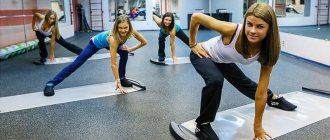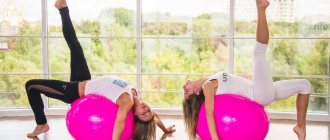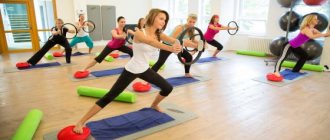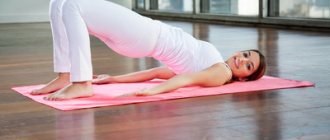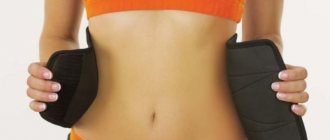Is it possible to lose weight by doing Pilates?
The ability to lose excess weight by doing Pilates depends on several factors:
- the frequency with which you practice,
- intensity of classes,
- type of diet.
Instructors recommend being realistic when setting weight loss goals. Although your desire may be to lose 5 kg per week, achieving this is almost impossible and even dangerous to your health. Aim for weight loss of 0.5 to 1 kg per week, but weight loss can be more intense if you also change your lifestyle.
Alternative
With all that said, there are still a lot of yoga supporters. Therefore, the question arises again: what is better, yoga or Pilates? These currently fashionable trends have something in common, but there is also a fundamental difference. Similarities:
- Lack of fast movements and numerous repetitions.
- Development of endurance.
- Figure correction.
- Help with weight loss.
- Help in finding peace of mind.
- Similar exercise technique.
- Particular attention to breathing technique.
- Strengthening the nervous system.
- Improving metabolic processes in the body.
- Strengthening the immune system.
There are, of course, differences. What is yoga like:
Yoga is an old teaching; it dates back several thousand years. It combines the wisdom and experience of many generations. Pilates is relatively “young”, it is only about a hundred years old. Yoga has a deep philosophy that unites the body and self-awareness. It develops concentration and raises self-esteem. Exercises, called asanas, are performed for several minutes without changing postures. In yoga, special attention is paid to the spine and back.
The significant difference between both practices is that they have different breathing techniques. The goal of Pilates is to saturate the muscles with oxygen, and yoga helps you control your own body.
We can say with confidence that Pilates and yoga are two types of fitness that anyone can start doing, regardless of their physical fitness and age. And your own choice should be based on what the future athlete has a greater inclination towards. So, what to choose: yoga or Pilates is up to each individual.
There is another fashionable movement in fitness - callanetics.
The development of this technique belongs to the ballerina from Holland Callan Pinckney in the 80s of the last century. She came up with this complex when she found herself in a very unenviable position. After a long journey, the ballerina experienced pain in her back, knees and severe fatigue. In addition, she had to undergo surgery.
Thanks to this complex, all her pain went away, and the participation of surgeons in her fate was not needed. The ballerina herself became stronger and even stronger. Distinctive features of callanetics: the method is based on static exercises and is effective for those who already have good physical training. Not every beginner can “pull” it, since the load goes on all the muscles of the body. So if you want to take up callanetics, then it’s better to start your sports path with Pilates.
The pulse does not increase during exercise, as in Pilates, which means that the complex is quite suitable for people who suffer from cardiovascular diseases, so this method will only improve the health of people who decide to take up this type of fitness.
As for muscle mass, it does not grow in callanetics, but gets stronger.
The technique is somewhat different from yoga, which will undoubtedly have a positive effect on health if you practice constantly and purposefully.
Of course, there are contraindications, as in any sport.
In callanetics, as in Pilates, the emphasis is on large muscles: thighs, buttocks, abdomen.
Both methods act in the same direction, but each in its own way. By doing one type of fitness or another, you can lose extra pounds, provided that the classes are regular and not from time to time. Needless to say, the effectiveness of the exercises directly depends on the correct technique.
So everyone can make their choice in favor of Pilates or callanetics themselves, based on their personal preferences.
How Pilates affects weight loss: reviews from athletes
There are always a lot of reviews on forums and in various fitness groups about how Pilates affects the weight loss process. Reviews are sometimes contradictory and this is not without reason for the following reasons:
- Many athletes expect immediate results as soon as they start exercising. Pilates is an excellent method for losing weight, but it requires a lot of time, diligence and regularity.
- If you don’t follow the technique of doing the exercises and don’t monitor your breathing, it won’t do any good.
- If you eat incorrectly - rarely and in large quantities, not only will there be no effectiveness from exercise, but you should even expect a slight increase in your own weight.
More on weight loss: things to consider
Regular physical activity is great because it not only helps you lose weight, but also improves your health. But in addition to proper technique and breathing, we must not forget about one more aspect - proper nutrition. If the diet is not balanced, then you should not hope for good results. Basic nutrition rules:
- Hearty breakfast. Cookies and coffee are not suitable here.
- You need to eat little and often.
- Carbohydrate foods are appropriate only in the first part of the day. This includes cereals, fruits, bread, confectionery, pasta, etc.
- You should not eat fatty foods before training - this can cause nausea during exercise.
- Eating meat and fish is recommended three hours before classes.
- After training, be sure to have a snack about half an hour later.
- You need to reduce your coffee consumption to a minimum.
- All types of carbonated drinks should be excluded from the diet.
- It is necessary to constantly maintain a drinking regime to maintain water balance.
- The use of natural juices is encouraged - preferably squeezed juice, as well as herbal infusions. You need to drink both during and after training.
How Pilates burns calories
Pilates burns calories quite slowly, but subsequently leads to significant weight loss. For example, a person burns 130 calories in 30 minutes of beginner Pilates, 181 in 30 minutes of intermediate Pilates, and 223 in 30 minutes of advanced Pilates.
The key to weight loss is creating a calorie deficit - which means burning more energy than you consume. Creating this overspending is possible through frequent exercise and a healthy diet. Since 0.5 kg of fat is 3,500 calories, a daily difference of 500 calories will help you lose 0.5 kg per week.
With regular training, it will take you about 30 days to noticeably lose weight.
For more intense weight loss, consider supplementing your workout routine with vigorous exercise, such as jogging or cycling. Read more about the best cardio workouts here.
Pilates results
With regular exercise, new capabilities and abilities of the body appear. This is due to deepening breathing, stimulating muscle function and improving blood circulation.
- The ability to control your body increases. The lumbar and pelvic area is stabilized, which leads to improved posture. Strengthening your back muscles gives you new opportunities to do more difficult exercises or movements.
- All muscles are trained. You can selectively work out individual muscle groups. The complex makes it possible to gradually work out each muscle group, even the smallest ones. In this case, natural poses are used, simple and understandable to perform. This stimulates muscle growth and rapid loss of fat tissue.
- Metabolic processes improve, which results in a reduction in body weight. Activating breathing enhances the process of burning fat, and training the abdominal muscles improves the activity of the gastrointestinal tract and excretory system of the body.
- The stabilizing muscles that support the internal organs and spine are strengthened. The natural line of the spine is aligned and the normal position of the organs is normalized. This leads to improved blood circulation and functioning of the whole body. There is a gradual loss of weight and improvement in appearance, the figure becomes slim and fit.
- Stretching muscle tissue. Gives them the necessary level of tone and elasticity, promoting the formation of graceful movements and plasticity, helping to avoid injuries and fractures due to falls or bruises.
When performing a complex, it is not the number of approaches that is important, but the quality of the exercises. Proper technique for each exercise will provide more benefits than numerous poor repetitions. Improper training can not only reduce the dynamics of weight loss, but also cause harm to health.
How to eat while losing weight with Pilates
To make weight loss more effective, it is recommended to reduce the size of your meals by 10-15 percent, fill your diet with healthy, low-calorie foods and eliminate alcohol consumption entirely.
Weight loss depends not only on training, but also on diet.
You shouldn't rely solely on calorie restriction to lose weight. If you eat foods high in sugar, processed carbohydrates and hydrogenated oils, you will not lose those extra pounds. Even so-called "health foods" such as yogurt and gluten-free bread can interfere with your weight loss due to their high sugar content. Read more about which foods help you lose weight.
To increase the effectiveness of Pilates, switch to a healthy diet with limited sugar intake.
Losing weight and getting healthier are possible
Pilates has a lot of positive reviews, but often it is not about weight loss, but about the healing effect. For example, 38-year-old Valentina, who has been doing Pilates for four years, has not noticed much change in her weight, but she is pleased with other positive aspects. “I got good stretching and abs appeared. The legs became toned and with well-defined muscles, the fat disappeared. I follow the Michelle Dozois program. The lesson lasts only 30 minutes, which is very convenient, since I have a busy work schedule,” Valentina said about her impressions.
45-year-old Lyudmila was similarly pleased with the results obtained, which also indicates that global weight loss was not achieved, but in general her figure began to look better. “I’ve been going to group training for five years. The weight didn't go away much, but the body became toned. I like the fact that I feel better; I don’t feel tired after training. Nothing hurts, I can move easily. I think that at my age this is an excellent result,” the woman is confident.
Many people also note more global changes in their body, when losing weight during Pilates became an additional pleasant surprise. “Initially, I went to Pilates to improve my posture, as I began to hunch over due to sedentary work. But in 4 months I lost 4 kilograms, although I did not strive for this. Volumes have gone well from the back and abdomen. I study by myself every morning for an hour. But I’m thinking about going to group classes and improving my results,” 30-year-old Ekaterina shared her experience and future plans.
With an integrated approach and a review of your diet, you can achieve truly impressive results. “When I saw the number 82 on the scales, I realized that it was time to come to my senses. I removed all harmful foods from my diet and stopped eating after 7 pm, and began drinking 1.5 liters of water daily. In addition, I began to regularly attend Pilates classes. In 8 months I lost weight to 65 kilograms. I want to lose a couple more, but even after that I don’t plan to quit Pilates,” said 27-year-old Elena.
Our eating habits play a key role in losing weight; by adjusting them, we can count on positive changes in appearance. Pilates in this case plays a secondary role. However, for those who do not like intense sports exercises, it is the best option.
Why you should choose Pilates
Benefits of Pilates:
- Pilates trains the deep internal muscles (intellectual muscles and small muscles), which helps burn fat and create a thin waist. Only with its help can you train the transverse abdominal muscle, which will noticeably tighten your stomach.
- Control of body symmetry . The spine is stretched, the shoulders relax and lower, the neck lengthens, and the trapezius muscle relaxes. The result will be a toned stomach and straightened posture, which will help you look slimmer.
- Adaptability to the special needs of each person. Chronic diseases, pathologies, fatigue, pregnancy and other conditions may not allow you to exercise, in the gym or on a bike. Pilates exercises are modified for almost every person.
- Burning fat . In Pilates classes, the main energy resource is fats. So the more effort, training and repetition you do, the better.
The concept of Pilates and its basic principles
When choosing one direction or another, first of all, you need to correctly assess your state of health, since strength exercises and high loads are not suitable for everyone. If you have heart problems, arrhythmia or various injuries, then one of the most effective ways to strengthen all muscle groups is Pilates.
This type of fitness is a unique set of exercises that strengthens muscles, the main priority of which is healing, increasing tone, and creating a beautiful and elastic body shape.
This method corrects posture, straightens the back, helps in the treatment of scoliosis in children and adolescents, tightens, makes the body more flexible and pumped up. With this method of losing weight, it is important to correctly use breathing technique, which is an integral part of all exercises. The most important thing in the technique is the quality, not the quantity of exercises.
The author of an amazing set of exercises is Joseph Pilates, who developed it in 1920 for athletes who have received various types of injuries and have contraindications to large power loads.
This type of fitness is popular not only in the United States. Recently, this direction has been successfully used in Russia under the guidance of experienced instructors.
Contraindications
If you have some symptoms and diseases, you definitely need to consult a doctor and an experienced trainer who will select an individual training system for you. Do not do Pilates on your own if you have:
- spinal conditions such as herniated or prolapsed discs, spinal stenosis, spondylosis, etc.;
- osteoporosis;
- hip or knee replacement;
- pregnancy or recent childbirth (check with your instructor about how and when you should exercise and modifications of exercises);
- febrile state and fever;
- mental illness;
- exacerbation of a chronic disease;
- the presence of a foreign body in the body near blood vessels;
- varicose veins (check with your instructor about how and when you should do it and how to modify the exercises);
- bleeding;
- injury;
- contusions;
- hematoma.
Pilates has virtually no contraindications, and anyone who can get to the gym can do it.
A set of simple and effective exercises
After warming up, you can begin the main training complex. The first Pilates exercise will help relax your spine. To do this, stand up straight, pull your stomach in, straighten your shoulders and bring your shoulder blades together. Then begin to slowly bend forward, drawing in your stomach even more. Reach your feet with your fingertips. Stay in this position for a couple of seconds, then smoothly return to the starting position. Repeat the exercise 5-6 times. At first it will be difficult for you to reach your palms with your feet, but in the future, with regular training, your flexibility will develop and you will be able to do this without difficulty.
To perform the second Pilates exercise for the stomach, lie with your back on the floor, place your arms along your body, palms down. Tighten your abs, pull in your stomach and, slowly lifting your shoulder blades off the floor, lift your body up. When you reach the point of maximum abdominal tension, hold there for a few seconds and then smoothly return to the starting position. Repeat twisting 5-6 times.
Remaining lying on the floor, lift your shoulder blades off the floor and stretch your arms forward. Raise your straight legs above the floor at an angle of 45 degrees. Pull your stomach in and press your lower back to the floor. Then begin to sharply and quickly hit the air with your palms - 5 times with your palms up and down. Slowly lower your legs and arms to the floor. Repeat this exercise 5-6 times.
Lying on your back, place your feet shoulder-width apart and bend your knees at a right angle. If your problem area is the back of your thighs, then try to perform this exercise with your legs bent not at a straight angle, but at an acute angle. Pull your stomach in and place your arms along your body. Tighten your buttocks and abs and begin to slowly lift your torso, starting from the tailbone and upward. Leave your shoulder blades and shoulders lying on the floor; they and your legs act as a support. Hold at the highest point for a few moments, then return to the starting position. Repeat this element 5-6 times.
Roll over onto your side, tense your abs, support your head with your bent arm. With the leg on top, begin to make slow rotational movements clockwise. When performing this Pilates exercise, the lower leg remains straight, and the upper leg should not bend at the knee. Rotate your leg for 30 seconds, then roll over to the other side and do this with your other leg. Do 2-3 approaches for each leg.
Roll over onto your stomach and pull your stomach in towards your spine as much as possible. Then lift your arms and legs off the floor at the same time and begin imitating quick, short kicks in the air, as if you were swimming.
Do this exercise for half a minute to a minute, as much as you can. Repeat 2-3 times. Pilates exercises must be completed correctly. The best way to straighten your back is to roll along the spine. Lie on the floor, press your knees to your stomach and rock on your rounded back.
Recommendations for Beginners
To achieve your desired weight, slim and fit figure, follow these recommendations:
Find a professional trainer
An experienced instructor is needed to help you gain basic knowledge about the intricacies of Pilates, without which it is impossible to achieve results.
Be realistic and think positively
At first, you may dream about how your figure will transform, but to achieve such a body, you need to work hard. Start by recognizing and perceiving yourself as you are now. Positive thinking is important.
Have patience
The results from Pilates classes come consistently. You must be patient. Practice Pilates regularly!
Don't demand the impossible from your body
Be prepared to experience some muscle discomfort, especially after your first sessions. But if you feel pain or discomfort, stop and report it to the trainer.
You are individual
Find out the Pilates exercises that fit into your daily life and follow them. Ask your instructor for recommendations for activities that fit your lifestyle. He can choose the most gentle or, on the contrary, an enhanced type of training.
Make time for Pilates
Set aside time to study regularly. Turn off your cell phone and computer and try to relax a bit. Choose time between meals. If possible, try doing Pilates before meals.
Do not do Pilates for 2 hours after eating.
Create free space when studying at home
Try to create a space that is bright, open and accessible to you without restricting your movement.
Create a program that suits you
You are unique, and Pilates, when creating its training program, spoke about this. Choose exercises based on your strength and strive for more.
Practice at your own pace
You don't have to get ahead of anyone, just enjoy your training and the results of your perseverance and work.
Controversial issue
I want to lose excess weight as quickly as possible. Therefore, it is important for people losing weight to know how many calories are burned in one workout.
And Pilates is a special kind of fitness. All movements performed during training are slow and continuous. This feature of the technique raises doubts among some people about its effectiveness in the fight against extra pounds. In addition, you will only burn 250 Kcal in an hour of exercise. Such figures sound very disappointing, because 1 kilogram of adipose tissue is filled with 9000 kcal! Simple mathematical calculations indicate that a loss of just 1 kilogram will occur in a month with intense daily hour-long training! This prospect is not encouraging.
However, numerous reviews of women and men who have lost weight with the help of “slow” exercises indicate the amazing results that these workouts helped achieve.
To understand whether Pilates helps you lose weight, you need to understand the principle of its effect on muscle and joint tissue.
Principle of operation
The fundamental principles of this system will help you understand how Pilates weight loss exercises work and what they are.
The technique was created as a system of rehabilitation exercises, with the help of which soldiers wounded during the First World War restored the capabilities of their body. After surgery or dangerous injuries, physical activity is necessary. However, it must be special, combining a gentle load with minimal risk of injury.
Pilates works in 3 important areas that ensure the achievement of the task:
- Breathing regulation;
- Controlling the body with the power of thought;
- Impact on muscle and joint tissue with gymnastic movements.
This complex effect of the technique on the body showed excellent results: the course of rehabilitation of the wounded was much faster and more successful.
In addition to the restorative capabilities of the Pilates exercise complex, the ability to stretch the ligaments and spine was noted. This property ensures flexibility and correct posture.
Deep breathing used during movements stimulates the metabolic process, saturating the blood with oxygen. This ability not only normalizes the functionality of the heart and blood vessels, but also affects intense energy consumption between classes. Strong muscles that appear as a result of training also require increased “release” of energy reserves. This means that kilocalories are burned not only during Pilates classes, but also between them! Moreover, after training, calories are burned even more intensely, because exercise tones the muscles, forcing them to work more actively.
Constant exercise, combined with the correct exercise technique, reduces appetite, so a person consumes fewer calories than he expends.
Pilates training strengthens the muscle frame of the most “problem” areas: thighs, buttocks, abdomen. Tightened muscles allow the silhouette to look slimmer and completely eliminate cellulite. Due to good drainage and oxygen saturation of the lymph, swelling goes away.
Therefore, losing weight with Pilates is real! This effect is achieved by wasting energy after and during exercise.
Training rules
Pilates will be effective and efficient if you adhere to certain rules:
- You need to breathe through your chest. As you inhale, expand your ribs to the maximum.
- All movements come from the press. It contracts and remains tense throughout the workout.
- All recommendations must be followed accurately and correctly.
- Shoulders are relaxed and lowered - this promotes proper breathing.
- Keep your head straight.
- The spine is stretched and under control - this increases the flexibility of the body and the back becomes mobile.
- Choose narrow and elastic clothes, you don’t need special shoes, training takes place barefoot.
- You will need a mat for practicing, for example, a yoga mat.
The influence of Pilates rhythm on weight loss
Sometimes Pilates is called “gymnastics for the lazy” or slow “aerobics”. The word "slow" is key in this process. Many people mistakenly believe that in order to lose weight you need to move faster. There will be results from quick classes, but this is no longer Pilates.
By exercising correctly according to the system, you achieve sustainable weight loss. Due to concentration, abdominal tension, proper breathing and slow execution, the muscles wake up and start working.
To summarize, we will dispel the popular myth about the uselessness of Pilates
You may have heard the opinion that Pilates, an exercise for losing weight, is not at all an effective activity, as trainers say about it. In part, this judgment has every right to exist, but only in comparison with other types of training: doing Pilates, you can burn from 200 to 400 kcal in 1 hour, while strength exercises burn up to 600 kcal in the same time, and intense training with cardio load is capable of “destroying” 800 kcal at once.
The difference looks impressive, but this is where we often forget about the fundamental difference between Pilates, which is a gentle technique. This means that you will not only lose weight, but strengthen your joints, make your muscles more elastic, and make your body’s immune defense more stable. Yes, the process will be a little slower, but remember - whoever drives quieter will definitely be further along.
By the way, Pilates is a great way to get in shape for those who started training for the first time or returned to training after a long break. By performing simple movements that force every muscle in your body to tense, you will gently prepare your joints and ligaments for further stress. For the same reason, Pilates with a weight loss ball is suitable for pregnant women, as it very gently and gently helps control weight.
By exercising, you learn to breathe correctly, develop endurance (both physical and internal), and most importantly, shape your figure with pleasure, without exhausting yourself with strength training. Strengthened immunity, a great mood and, in a good sense, a smooth emotional background are a bonus for everyone who discovers Pilates gymnastics.
Exercises (video instructions)
The Pilates system uses 3 types of exercises:
- on the floor;
- on special simulators;
- using additional equipment.
In the video “Effective Weight Loss,” trainer Elena Skachko will demonstrate exercises that are accessible to anyone at any age. Performed on the floor:
A form of training for weight loss on simulators is recommended for people with problems with the musculoskeletal system or to add variety to exercise. The most popular is the reformer - a movable platform with slings and a footbar. On the reformer, exercises are performed under the supervision of a trainer in a specially equipped room.
You can watch the video on how to perform Pilates exercises on the reformer. During such a workout you can burn up to 200 kcal:
Strength training with dumbbells, in addition to getting rid of fat deposits, makes the body more sculpted, strong and toned. Practiced in the gym, at home or outdoors. Performed with a trainer or independently at a more advanced level.
The Pilates system also uses bands, fitballs, elastic bands, gymnastic sticks and small balls. All equipment helps to use “dormant” muscles and activates their work.
The video shows how you can use an elastic band in Pilates classes. Such exercises allow you to get rid of sagging body and sagging skin, which is important when losing weight.
Three-level course by Alena Mordovina
Another know-how of Alena is her three-level course of classes. The initial complex is intended for beginners and can include about 15 lessons. Intermediate level – approximately the same volume, but with a different set of exercises. Pilates for advanced – developed by Alena for everyone who found the basic level of difficulty not enough. The duration of the lesson at each level is approximately the same and ranges from 50 minutes to 1 hour.
First level
Designed for beginners, seniors and those going through a period of rehabilitation after illness, Pilates with Alena Mordovina, representing the entry level, is mainly focused on teaching the “skills” described above - which is clearly visible in all the video lessons of this starter course.
In addition, Alena talks a lot and in detail about her methodology at the beginning of classes - explaining how to perform certain exercises and why proper breathing and concentration are so important.
Each lesson consists of 2 parts - the main one, devoted to the simplest movements at a smooth pace, and the final one, teaching how to relieve fatigue and tension.
Average level
For those whose physical fitness already allows them to move on, Pilates with Alena Mordovina offers an average level of load, and in the corresponding videos the instructor explains and shows how to maintain a straight back, how to develop “muscle memory” in the body, and how to achieve perfect accuracy in movements. Lessons are no longer divided into two, but into three parts. They consist of: warm-up, main part and relaxation.
Advanced level
Alena created her advanced Pilates course specifically for true fans of building a “smart body” - and her video lessons are replete with complex exercises (including using dumbbells).
The principles of time division of approximately an hour of classes are the same:
- warm-up (warming up muscles, working on breathing, psychological mood);
- the main part is a lot of movements, during which all the basic principles of Pilates, preserved in the memory of your muscles, are automatically applied;
- relaxation – proper restoration of breathing, passing a “wave of heat” through the body, relaxing muscle tissues and ligaments, saturating them with oxygen.
